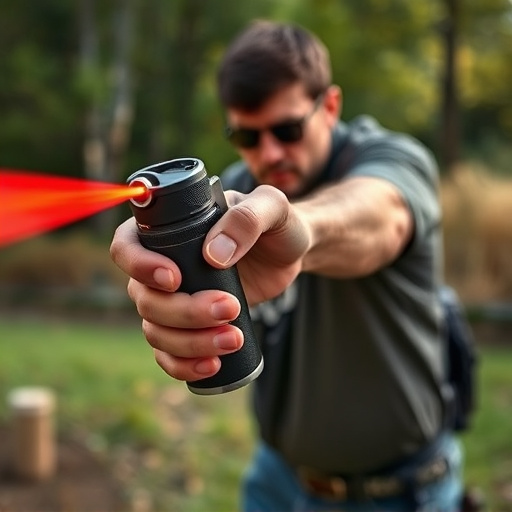Pepper Spray Training for Beginners is essential to ensure safe and effective use of non-lethal self-defense tools like pepper spray, which temporarily incapacitates attackers without causing permanent harm. Training should cover mechanics, handling techniques, deployment range and methods, de-escalation tactics, local laws, aiming at eyes or face, short bursts for maximum disorientation, and minimizing cross-contamination risks. Practicing in open areas and regular refreshers are crucial for maintaining proficiency.
“Unleash your inner strength with a powerful yet non-lethal inflammatory defense tool—pepper spray. This comprehensive guide, ‘Pepper Spray Training for Beginners,’ takes you on a journey from understanding its fundamentals to mastering effective usage. Learn about the benefits of non-lethal self-defense and discover how pepper spray can be your secret weapon. We’ll demystify its mechanics, offer expert tips for selection and application, and provide training insights to ensure responsible use. Get ready to take control with confidence.”
- Understanding Pepper Spray: A Beginner's Guide
- Benefits of Non-Lethal Self-Defense Tools
- Choosing and Using Pepper Spray Effectively
- Training Tips for Responsible Pepper Spray Use
Understanding Pepper Spray: A Beginner's Guide
Pepper spray is a non-lethal inflammatory self-defense tool that has gained popularity as an effective deterrent for personal safety. For beginners considering pepper spray as an option, understanding its mechanics and proper usage is crucial. Pepper spray functions by irritating the eyes, nose, and respiratory system through the release of capsaicin, the same compound responsible for the heat sensation in chili peppers. This irritation temporarily disables an attacker, allowing users to escape or seek help.
Training for beginners should focus on learning basic handling techniques, understanding range and deployment, as well as post-application care. It’s essential to participate in hands-on Pepper Spray Training for Beginners to familiarize oneself with the sprayer’s mechanics, practice safe deployment, and learn how to mitigate potential cross-contamination. With proper training, individuals can gain confidence in using pepper spray effectively while minimizing risk to themselves and others.
Benefits of Non-Lethal Self-Defense Tools
Non-lethal self-defense tools, like pepper spray, offer a range of benefits for individuals seeking to protect themselves in various situations. Unlike lethal options, these tools are designed to incapacitate or deter attackers temporarily without causing permanent harm or death. This is particularly advantageous for beginners who may feel more confident carrying and using a non-lethal option, knowing they’re not putting someone’s life at risk.
Pepper spray, for instance, is a popular choice due to its ease of use and effectiveness. With proper Pepper Spray Training for Beginners, individuals can learn how to deploy it accurately and safely, ensuring its potency is directed towards the attacker. This level of training also helps users understand when and how to use pepper spray, minimizing the risk of self-injury or accidental deployment in inappropriate situations.
Choosing and Using Pepper Spray Effectively
Choosing and using pepper spray effectively requires a balance between self-defense power and control. For beginners, starting with a non-lethal, low-to-mid concentration pepper spray is recommended to understand its range, effect, and safe handling. Proper Pepper Spray Training for Beginners should include learning the spray’s reach, aiming techniques, and understanding the eyes’ sensitivity as the primary target. Practice in open areas ensures minimal cross-contamination and allows users to become familiar with the spray’s effects without causing serious harm.
Once comfortable with basic usage, individuals should learn de-escalation tactics. This includes verbal commands and body language adjustments to discourage potential threats before resorting to pepper spray. Knowing local laws regarding its use is also vital. Effective deployment requires a firm grip, aiming at the face or eyes, and activating the spray in short bursts to maximize visibility and disorientation while minimizing the risk of inhalation, which can be dangerous.
Training Tips for Responsible Pepper Spray Use
For those new to pepper spray, proper training is essential for responsible use. Pepper spray training for beginners should focus on understanding the device’s mechanics and its effects. It’s crucial to learn how to properly hold and activate the sprayer, ensuring accurate targeting while minimizing cross-contamination. Practicing in a controlled environment allows users to familiarize themselves with the spray’s range, wind effects, and duration, enabling them to deploy it effectively during unexpected encounters.
During training, beginners should also be educated on de-escalation techniques, as pepper spray should only be used as a last resort. Understanding local laws and regulations regarding its use is vital, along with recognizing when and where it’s appropriate to deploy the spray. Regular refreshers and scenario-based drills can help maintain proficiency, ensuring that individuals are prepared to handle potentially dangerous situations while adhering to ethical and legal standards.
Pepper spray, as a non-lethal inflammatory self-defense tool, offers individuals a powerful means of protecting themselves while emphasizing safety through proper training. For those new to pepper spray, understanding its mechanisms, benefits, and responsible use is key. By following the guidelines outlined in this Pepper Spray Training for Beginners guide, you can gain valuable knowledge on choosing, using, and training with pepper spray effectively, empowering yourself with a crucial skill in personal safety.
